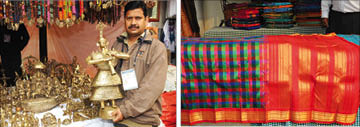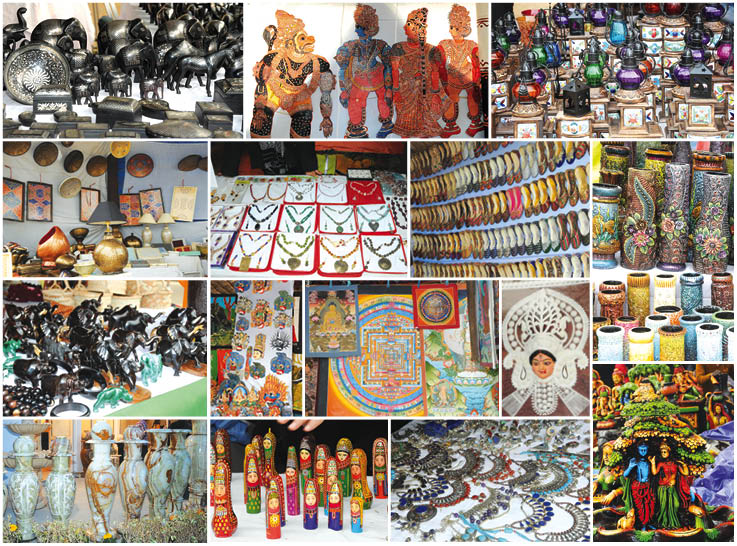Outside the ambitious and aggressive urban art-and-crafts arena, the relative rusticity of the annual Surajkund International Crafts Mela makes it a necessary alternative to the city’s gallery and craft-boutique circuits. The idea of the Mela is to provide rural craftspersons an opportunity to sell their products directly, sans interference from urban middlemen. This year’s crafts melee, that includes over a dozen countries, marks the Mela’s 27th year. This huge fairground has been spruced-up and made more visually appealing this year, with some new amenities --- such as a separate ‘boutique and cafe’ area, monitored offices with computer facilities, CCTV cameras and a distinctly upgraded environment. The Mela was inaugurated on 2nd Feb. by President Pranab Mukherji.
Each year focuses on a theme state; Karnataka is highlighted in 2013. This southern state, whose districts include Bangalore, Mysore and Udupi, is rich in ancient silk-weaving techniques, textile-designing and intricate sculptural traditions. Over 300 Karnataka master-craftspersons, artists, weavers, dancers and musicians have assembled for two weeks—from February 1-15—at Surajkund, to demonstrate and offer their crafts skills at the Mela. Many other states are also represented. Spread over 40 acres of hilly tract, Surajkund houses nearly 800 separate work-and-display thatched huts to showcase indigenous crafts.

Highlighting the history of the theme State, many massive gates—over 40 feet tall—have been constructed, replicating the gates of the Mysore Palace, the heritage-sites of Hampi and Belur, pre-historic tribal metal sculptures, and Bijapur. Remakes of Kurukshetra’s historic ‘Geet-Dwaras’ further decorate the vast fairgrounds, along with large ornamental sculptures depicting symbolic Indian Surya, peacock and tree-forms. The region bears considerable historicity --- in the 10th C. A.D., a ‘Sun Pool’ was constructed on these very Surajkund grounds by Raja SurajPal, and the area was restored by Ferozeshah Tughlaq in the 14th C.
This Mela also has an extensive open-air theatre Natyashala, and a ‘Chaupal’ for live performances – which can be used inventively. It also has an expansive food court. These aspects however remain at a very conventional level, with scope for much more sophistication in both the Mela’s performances and its cuisines. A better, more authentic range of Mysore and Udipi cuisine should certainly have been organised at the event, rather than most stalls offering typical Chinese and Rajasthani street food.
Although tribal dances from India and Africa are always a consistent part of the Mela, these performances remain trapped at the most basic and rustic level. Modern theatre performances, alternative experimental expressions, and evenings devoted to serious productions by special invitees from the performing arts should be made an intrinsic aspect of this fortnight-long crafts carnival. This year Surajkund intends to upgrade the performance area somewhat, by including a fashion show of the Karnataka designer Prasad Bidappa on the 9th of February. The intention is to showcase the magnificence of the region’s silks in a contemporary stylistic manner. However, Karnataka’s ancient folk theatre forms of Yakshagana and Nagamandala also need to be presented at the Mela with greater finesse.
The Mela’s popularity enables many craftsmen to get orders for their specific crafts years in advance, and hence they return to Surajkund annually with fresh products. Given the possibilities that such a massive space and its location offer, the Mela needs to concentrate on higher quality-control, and more skilled displays of the finest crafts products.
Among the highlights of this year’s mastercrafts are the high quality of Mysore silk saris on offer, alongside live demonstrations by their actual weavers. Karnataka has been chosen as a Surajkund theme State for a second time, after a gap of 18 years. Undoubtedly, one of this State’s greatest skills lies in its pure-silk handloom weaving, with exceptional silk saris created in exquisite colours and designs. Such ancient weaves, under the ‘Priyadarshini Handlooms’ label, are being developed in Karnataka’s Chitradurga and Tumkur Districts. In geometric and floral designs, these textiles and saris come with a high stylistic heritage, and are covetable worldwide.
The flamboyant mythical wood-carvings of Karnataka are also well-represented by an array of powerful multi-headed Ganeshas, Devis and other deities, superlatively carved in larger-than-life classical formats.
Karnataka also contains a Banjara Tribal crafts tradition, exemplified by the dramatic hand-embroideries of this ancient nomadic gypsy clan, somewhat similar to the Rabaris of Kutch and Rajasthan. However, there is not enough Banjara representation at this year’s Mela. Noticeable by their striking mirrored headgear and embroideries, this rare tribe requires greater sustenance and patronage. However, there is only a sole elder woman embroiderer producing a few bags in a small stall. Other than that, local girls wearing vibrant Banjara attire are a part of the visual pageants and performances, to provide touristy local colour and a few ‘kodak’ moments.
The other high point of this year’s Mela is the presence of a master-sculptor from Bengal, exemplifying the best of its ancient Dhokra tribal metal-sculptural tradition. State awardee Rajib Kumar Maiti's intricate, miniature mythical depictions of the Tree Of Life, Krishna, Durga, and secular sculptures of Rickshaw-Pullers add aesthetic authenticity and charm. The fine Patachitra scroll-painters of Orissa and Bengal, and South Indian Kalamkari artists should be encouraged to showcase their best works in all future fairs at Surajkund.
As for Surajkund’s ‘international participation’, this is another area that appears perfunctory, and definitely needs streamlining. Africa is home to a vibrant textile and wood-carving tradition, but its complex variety is not displayed at Surajkund at all, despite nine African nations participating The fine green Haematite sculptures of Ghana and Congo are represented by just a handful of small animal sculptures, gracefully depicting African rhinos and leopards. .
Neither is there a wide-enough display from the reclusive Eurasian nations of Tajikistan and Turkmenistan, which offer a few wooden dolls painted in enamel, and some small stray paintings that lack a unifying thread. Afghanisthan offers some vibrant ethnic garments and silver jewellery, which conveys a magnetic visual impact. However, there is practically nothing at Egypt’s stall, which seems sadly bereft of ideas, aside from an interesting collage depicting a mystical Bird form.
Pakistan has brought across a wide range of large, heavy marble decorative vases, water-fountains, pedestal-stands and decorative birds for outdoor or indoor use, as well as smaller versions of the same. Crafted of smooth marble and stone, in subtle shades of ivory and cream, these are handiworks worth savouring. By contrast, Thailand’s tacky plastic wares were the weakest items on display.
Our neighbouring nations of Bhutan, Nepal and Sri Lanka have a formidable visual and spiritual heritage. Their stalls display an impressive but small selection of Buddhist Thangkas, iconic masks and semiprecious talismans. However, such masterly skills could have been showcased on a much wider scale.
The lacuna at Surajkund is precisely this randomness and lack of curated craft-structure, thereby not utilising the overall possibilities of such a vast space. Surajkund needs a full-time team of Crafts Leaders to polish up its act, if it is to be taken seriously on the crafts map. The Surajkund Mela certainly offers a pleasant day-outing, with excellent expanses for a leisurely stroll while browsing a wide assortment of handmade bric-a-brac.

Read More...